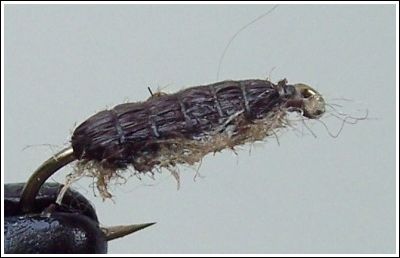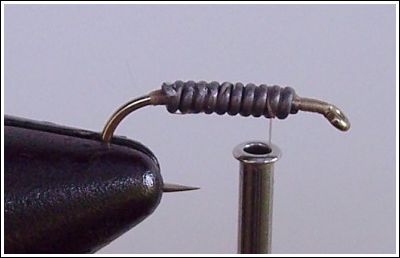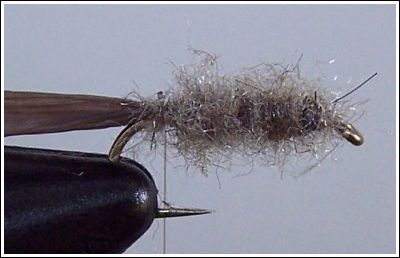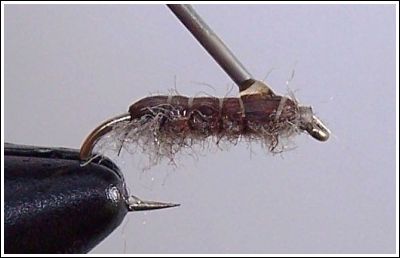|
Tying Mr. Sowbug's
Dead-Drifter Sowbug
By Fox Statler

Charlie
Brooks stated in his book, "Nymphing For Larger Trout", that if sowbugs
and scuds are in the stream, they can make up as much as seventy-five
percent of the trout's diet. I read this book three times because of one
sentence. Mr. Brooks described how to fish every bug in his book -
except sowbugs and scuds. On fishing them he simply stated, "You are on
your own". That statement was quite a disappointment thirty years ago. I
thought I might gain an important tip on how to fish the two dominant
aquatic insects in the White River system. After more research, I found
that Mr. Brooks didn't occupy his time with small Isopods and Amphipods.
Brooks was a large nymph fisherman. Now believe it or not, Charlie
Brooks had the most profound influence on my sowbug patterns but not
from his book, instead, a small tidbit that was written about how he
tied his patterns in a flyfishing magazine. A very small point that the
author had forgotten and added in the last paragraph of his article. One
small sentence changed sowbugs forever and sent me, a middle-aged man,
on a life long quest. The sentence simply stated that Mr. Brooks always
tied his flies "in the round" because a swimming nymph always righted
itself before it swam away. Tying in the round meant that regardless of
the position of his fly, it appeared upright. This meant, if the bug had
a wing case he tied his fly with a wing case on all sides. My sowbugs
were just the opposite. They couldn't swim. They possessed not a
swimming appendage. They were and are crawlers. Every sowbug that I had
fished to that point was one color with a clear plastic latex back. The
greatest improvement I made on the sowbug was making it two colors.
Over thirty years ago, the White
River system had but just a dab of Mother Nature's aquatic and pseudo
aquatic insects. There were no stoneflies, a couple crane flies, and
occasionally a mayfly and caddis hatch. The bulk of the trout's diet
were sowbugs with a few scuds for variety. Sowbugs were so thick that at
times you couldn't find the toes of your waders, because they were
literally covered them up. I can remember thinking, "How do you catch a
fish when there is so much food available". However inventing the
"Wheel" was fun and I would love to do it again on another river.
Sowbug have probably caught more
trophy trout than any other pattern. Large Browns, Rainbows, Cutthroats,
and Brookies have all succumbed to its deception. Sowbugs are fished
from the Big Horn River to the small no-named spring fed streams of New
England. Sowbugs have several names: crest bugs, roly-polys, pill bugs,
and so on. But if you see a horizontally flattened insect with seven
pairs of legs, two antennae, two tails, seven body segments plus the
head and tail segments - you have just found yourself a sowbug.
Sowbugs are considered one of
the lowliest of flyfishing's bugs by most anglers - only superseded by
snails, leeches and planarians. And the method of presentation - the
using of an indicator, bobber, or float is lower than a "snake in a
wagon rut" - totally not flyfishing. It is the closest thing to bait
fishing that you can do. You cannot imagine the thousands of times I
have heard comments of this sort. Early on, I found the best way to
squelch remarks of this kind was to follow the guy around and catch
fifty fish while he caught five. Then upon my leaving I would say
something like, "I hope they are biting better tomorrow", "sure was a
slow day wasn't it", "I only caught five over four pounds and one over
six". If this didn't generate the response I wanted, I would find the
guy and fish beside him the next day. I never knew that flyfishing had a
violent side to it. I mean - I have heard of golfers throwing temper
tantrums, but fly fisherman? Flyfishing is to be pleasant, soothing,
relaxing, bonding one with nature, a metaphysical cosmic experience, and
things like that. It's not to end with the snapping of ones rod over the
knee, wildly flinging your entire rig into the river by the tip section,
breaking your foot upon drop-kicking a solid piece of Ozark bedrock as
you leave cursing loudly about some guy in a homemade fishing vest that
uses a bobber. This is how I became a guide, some would say it was not
the right approach. But I figured what the heck. Isaac Walton in his
book, "The Compleat Angler", mentioned using an indicator even if he did
call it "An Over Bug".
It's really too bad that a lot
of fly fisherman don't see the beauty of the sowbug. I mean think about
it. The sowbug doesn't sprout wings and fly away. It's in the stream
every day, maybe a little bigger or smaller, but it is always there. In
July and August, you might have to add some white dubbing to the head
portion of your sowbug pattern to imitate the egg sac that sowbugs carry
with their front pair of legs. Or when you visit a different part of the
river or another river, its color may vary some. And just think about
how many of these bugs it takes to fill up a fish - hundreds. That is a
lot better than ten minnows eaten early in the morning because - you
have hundreds of opportunities to catch the fish all day long instead of
just ten in the morning. If they occupy seventy-five percent of a fish's
diet, that's seventy-five days out of a hundred that the sowbug is what
they are feeding on. What other food item, other than scuds, can offer
as much consistency throughout the year? All in all, every day of the
entire year the sowbug is a valuable, easily accessible food item. I
have often remarked that Mother Nature gave the Ozarks just a smidgen
and not much diversity in its cold water streams, but what she gave them
was the best part.
I am planning to make a DVD on
the tying and the dead-drift fishing techniques of nymphs. I started
this project once but it got lost in the making, so we will attempt it
again. In fact I have planned several DVD's on my patterns and fishing
methods.
Tying the Dead-Drifter Sowbug
The sowbug, along with several
other nymphs, are very easy to tie. It takes me less than two minutes to
tie one. This is also true of several other common nymphs. Here are the
steps of the sowbug in a nutshell: hook, lead, thread, back, dub,
flatten, segment, finish, and coat. Did you notice I didn't say tail? I
don't put tails on my sowbugs but I do on some of my other nymphs. We
will expand each of these steps and include some pictures as we go.
Hook: Place the hook in your
vise. I always use dry fly hooks for my nymphs. I prefer "Straight-Eyed"
hooks to any other style. Why? Dry fly hooks are fine wire and penetrate
the flesh and bone of the fish's mouth with less force. This is
especially advantageous when using 6X and smaller tippets. Straight-Eyed
hook have more useful hook gape for the fisherman than Turned-Down-Eyed
hooks. My favorite hooks are Dai Riki 310 in #16 and smaller and Dai
Riki 305 in #14 and larger. Dai Riki does not make the 310 in sizes
larger than #16. TMC 103BL are okay. They are not straight-eyed but they
have a superior point and come in the odd sizes which I like because of
their proportions of the finished bug.
Lead: Match the lead to the size
of the hook shank and place ten wraps in the middle of the hook shank. I
use 0.010" lead for #18-#19 hooks, 0.015" for #16-#17, 0.020" for
#14-#15. I rarely use sowbugs larger than #14 but if you do jump up the
next size of lead for the next size of hook (0.025" for #12, and so on).

Thread: Start the
thread at the eye of the hook and wrap back until the lead is in the
center of the hook shank. Reach behind the lead and put five or six
wraps of thread. Then put several wrappings (3-4) of thread over the
lead and end up with the thread in front of the lead. I prefer 8/0
Uni-Thread in tan or light gray.

If you are going to put on the tails or
antennae now is the time to do it.
Back: When it comes to my Swiss
Straw color for the back, I am very particular. I dye my own. I use
Silver Gray Swiss Straw and dye it with Khaki Green Rit Dye. You can't
buy Khaki Green Rit Dye any more but if you go to the Rit Dye website
there is a formula for making it. Use you a pint glass jar, fill it with
water and add enough dye that you barely can see through it. Place it in
the microwave and get it hot. Take the Swiss Straw off of the card and
put it in the hot dye. Stir. Check frequently until the Swiss Straw is
the color of your sowbugs back. Rinse immediately. Take it outside and
drape it over anything ( chairs, bushes, what ever) and let it dry.
After drying put it back on the card. Cut off about a four inch piece.
Open the straw up and lay it flat on a cutting board. Split the straw
lengthwise into 1/4 inch strips for #19-#16 sized sowbugs, 5/16 inch for
#14-#12 bugs, and 3/16 " for bug less than #19. Place the strip of straw
over the lead and hanging off the rear of the hook. Wrap it down. End
with the thread in front of the lead.

Dub: I am just as
particular about the color, length, and texture of my dubbing as I am
about the color of my backing. I blend my own dubbing because I want it
the right color, length, and a leg material blended in. I start with
Wapsi's Dark Sowbug Antron dubbing chopping it to about 1/4 inch
lengths, then add gray Xylon Doll hair chopped to about 1/4 inch. Blend
these two together and check your color. It is usually too dark and a
poor match of the real bug. Add Wapsi's Light Sowbug Antron dubbing
chopped to 1/4" length to lighten it and a small amount of olive dubbing
material also chopped. Continue to add the light dubbing until you get
the desired color. Once you have attained the desired color chop all of
the material one more time, blend together and now you are ready. Wax
about 3 inches of your thread with a high tack dubbing wax. Take a wad
of dubbing and touch it to the waxed portion of the thread. The dubbing
should not be too thick and evenly covering the thread. Wrap the thread,
covering the lead from the front of the lead to the back of the lead. I
do not pick out or fuzz my dubbing after it is on the lead. Sowbugs have
seven pairs of legs not a hundred and seven.

Flatten: Take a pair of square
nosed pliers and flatten the dubbing and the lead. Don't flatten it too
much or it will ruin the bug's durability, but flatten it firmly.

Segment: Bring the strip of straw
over the dubbing from the rear of the fly to the eye. Begin to segment
the straw about a 1/16 inch apart working your way to the front of the
pattern. As you are segmenting the straw keep tension on the straw so it
will remain open and kind of cup around the bug's body.

Finish: At the head of the fly
place a couple wraps, trim off the straw and whip finish.

Coat: I usually tie 10 to 25
sowbugs and stick them in a piece of foam tape or styrofoam before
coating the backs of the bug with a thinned down head cement or
Hard-As-Nails clear fingernail polish. I thin both of these to about 1/3
strength by mixing with a thinner like acetone. Why? Because I don't
want the glue to build a thick coat on the back of the straw but to be
absorbed into the materials and glue the thread to the straw back and
the straw back to the dubbing and the dubbing to the lead. This makes
the bug a very strong durable unit.

All done, finished fly

Texy and photo by Fox Statler 2008 ©
http://www.willowford.net/ |